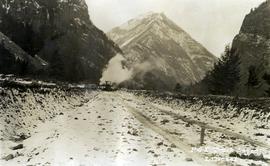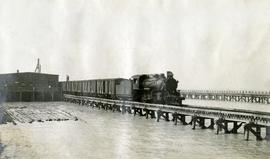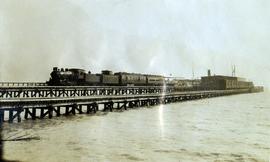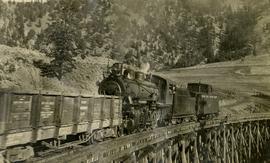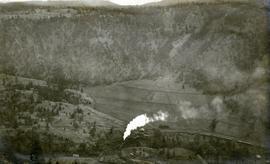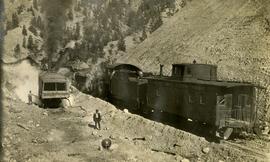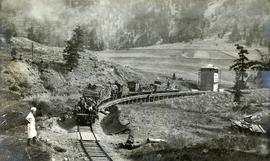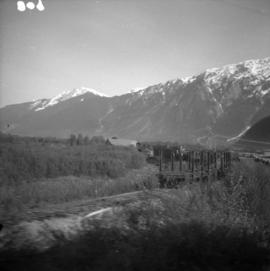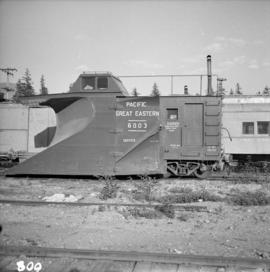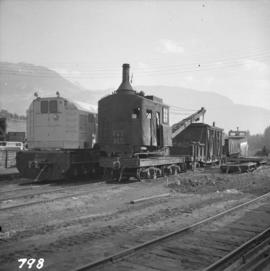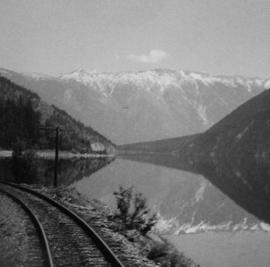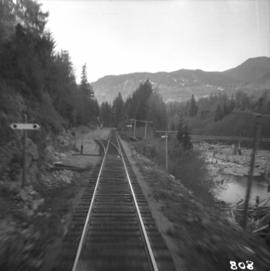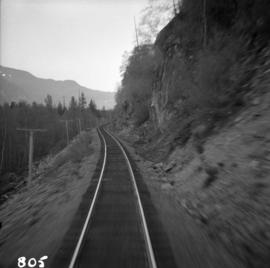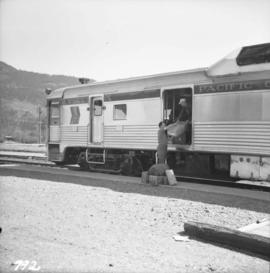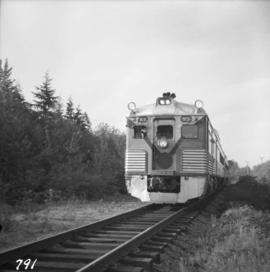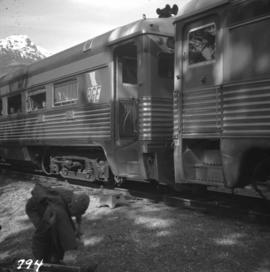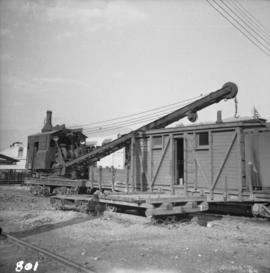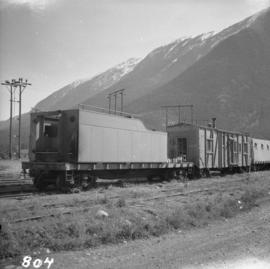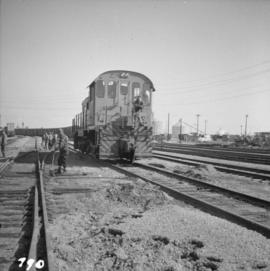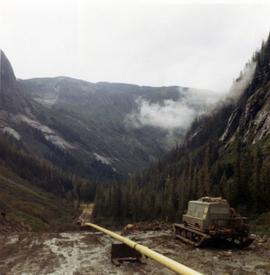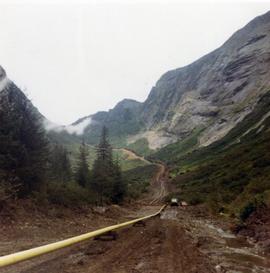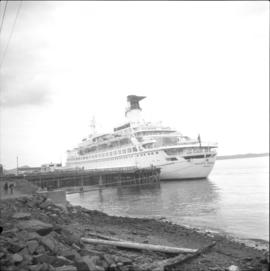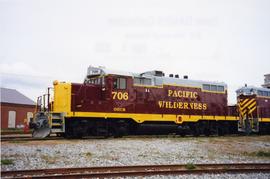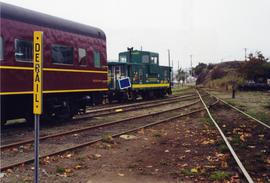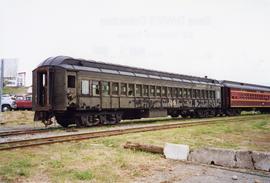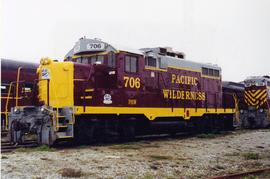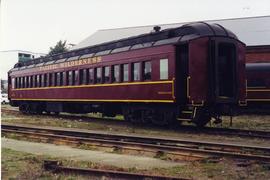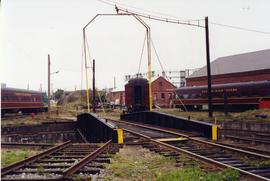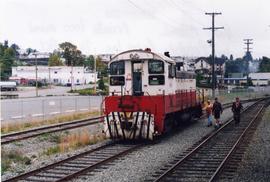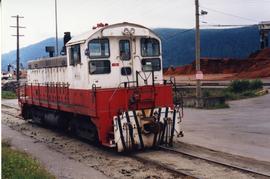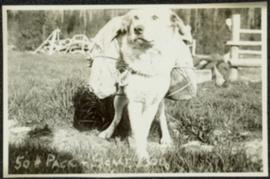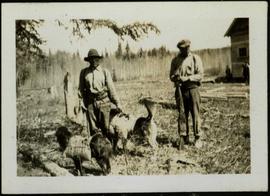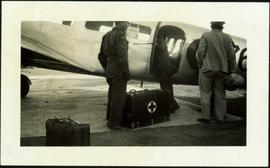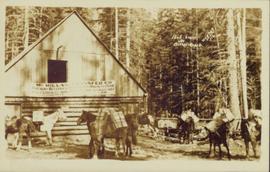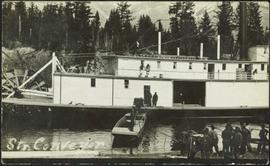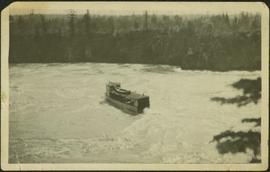This original film footage clip depicts the a Pacific Great Eastern Railway (PGE) Budd Car running along Seton Lake.
This original film footage clip depicts a Pacific Great Eastern Railway (PGE) Open Passenger Car riding along Seton and Anderson Lakes in British Columbia.
This original film footage clip depicts the inaugural train run of the Pacific Great Eastern (PGE) Railway line into Fort St. John in Oct. 1958. W.A.C. Bennett stops to speak at communities along the route, including Prince George and Dawson Creek. Other personalities, such as "Ma" Murray were also in attendance. The train was called the "Peace River Special". BC centennial flags are visible at the events. This film clip is believed to be a continuation of film clip 2017.5.2.3 "Pacific Great Eastern Railway (PGE) Trip with Premier Bennett from Vancouver to Prince George".
This original film footage clip depicts a Pacific Great Eastern Railway (PGE) track inspection trip with a V-10 Vehicle from Fort Nelson to Fort St John, October 1971.
This clip of original film footage depicts Pacific Great Eastern Railway (PGE) track inspection with a V-10 vehicle.
This original film footage clip depicts Pacific Great Eastern Railway (PGE) track inspection with a V-10 vehicle from Fort Nelson to Fort St John in October 1971.
This clip of original film footage depicts Pacific Great Eastern Railway (PGE) track inspection with a V-8 vehicle.
Clip description with timing reference to scenes:
- 0.01 The Fraser River above Marble Canyon near Moran
- 0.22 At the Tunnel at mile 168.9 between Fountain and Glenfraser
- 0.25 Scenes at Moran mile 181
- 0.37 Inspecting the 2 tunnels at mile 186.5
- 0.44 Water tank just north of Kelly Lake and south of the wye at Kelly Lake Mile Mile 191.5
- 1.04 Wood Trestle at 51 mile creek Mile 206
- 1.15 Lac La Hache station and section house in the background
- 1.30 Williams Lake station
- 1.43 Lone Butte Water tower
- 1.46 The Lone Butte rock formation
- 2.01 Alta Lake station right and Water tower in distance
- 2.06 Outside the east side of the Squamish roundhouse. Track ahead of car leads to yard. Water tower to right
- 2.15 A shot of the back side of the Squamish roundhouse looking south. 563 has had its trucks converted from 6 wheel to 4 wheel and is looking real clean. This must be late 1954. Steam locomotive 163 in final months of service and was cut up for scrap in July 1956
- 2.20 Cheakamus
- 2.24 Garibaldi Mile 59.5. Line to the left goes to the sawmill there
- 2.27 Inspecting the bridge at mile 55.6 in the Cheakamus canyon. Looking south from the south end of the bridge. Telegraph wires in the right of clip
- 2.31 Same bridge looking north
- 2.37 Bridge at mile 56.5 in the Cheakamus Canyon
- 2.42 Stopped at the water tank at the place called Watertank mile 62.5. Section house to the right of tracks.
- 2.58 Heading north around Pinecrest Mile 64 or 65
- 3.07 Stopped at the mill at Parkhurst around mile 80 on the east side of Green lake
- 3.23 Watching a south bound train pass at Tisdall
- 3.32 Diesel hauled train coming to Tisdall at the old location of the north switch. Locomotives still with their 6 wheel trucks so before 1954. Note locomotives spread out in the train so all the weight was not on small bridges at one time
- 3.50 In the canyon north of Lillooet; man in brown suit and fedora is W.H. (Harry) Nichols
- 3.58 Along Alta Lake
- 4.12 Scenes along Anderson Lake north of Darcy
- 4.35 Royal Engineers bridge at Lillooet
- 4.42 GE diesel with either steam ditcher or steam crane just north of Lillooet
- 4.47 General Store at Pavillion Mile 178.2
- 4.52 Quesnel Station
- 5.04 Unknown Location
- 5.20 Gang working with tamping machine?
- 5.31 Cottonwood River Bridge. New just before the line to Prince George opened in 1952. Also scenes around the Cottonwood River
- 5.57 Ahbau Creek Bridge Mile 406.1 Prince George Subdivision. The last spike to complete the line to Prince George was driven at the north end of this bridge. Ahbau Creek was named after a local Chinese prospector and trapper
- 6.16 At the CN Prince George shops near to where the Correctional Facility is today. CN Bridge across the Fraser River in distance
- 6.37 Construction of the PGE crossing of the Fraser River at Prince George
- 6.59 PGE middle yard at Prince George
- 7.10 Heading back south to the main yard. CN Fraser River bridge in shot
- 7.22 Marguerite station
- 7.35 Hawks Creek or Deep Creek Bridge mile 329.9. One of the worlds highest railroad bridges at 312 feet high
Note: The miles in the notes are the current mileages. At the time of the filming the line to North Vancouver had not been completed. The mileages at that time would have read 40 miles less in the mile boards.
This original film footage clip depicts a Pacific Great Eastern Railway (PGE) train trip in winter from Lake District to Alta Lake.
This original film footage clip depicts a Pacific Great Eastern Railway (PGE) Trip with Premier Bennett from Vancouver to Prince George in 1958. This is believed to be the beginning part of the inaugural train run of the Pacific Great Eastern (PGE) Railway line into Fort St. John in Oct. 1958. The second part of this clip is believed to be "2017.5.2.5 - Pacific Great Eastern Railway (PGE) "Peace River Special" inaugural train to Fort St. John, 1958".
This collection consists of photographs and "real photo" postcards that depict the construction and operation of the Pacific Great Eastern Railway line, communities nearby the railway line, and regional geography of areas adjacent to the PGE line.
File consists of documentary photographs taken by David Davies of the Pacific Great Eastern Railway Seton Portage Wreck in British Columbia.
Photograph depicts Pacific Great Eastern Railway track laying near Lillooet during railway construction. In the foreground, the railway grade along the south side of Cayoosh Creek about 1.5 miles before the junction with the Fraser River is depicted.
Photograph depicts a Pacific Great Eastern Railway train at the Squamish dock.
Photograph depicts a Pacific Great Eastern Railway train on the original dock at Squamish (Newport); the vessel in the distance behind the warehouse is quite likely the "MV Ballena", the subject of photograph 2020.08.01.
The equipment shown in this photograph is: Locomotive 51 or 52, built by Montreal Locomotive Works in 1913; caboose C-1, built by National Steel Car, Hamilton, Ontario in 1914; baggage-mail car 51 or 52; passenger coach 2, 3 or 4; and an unknown flat car outfitted as a sightseeing car with canopy. The time-frame for the photograph is between June 8, 1915 (when baggage-mail cars 51 & 52 arrived at Newport Dock) and some time in 1918 (when caboose C-1 was re-numbered to 1801).
Additional information on baggage-mail cars 51 & 52 and coaches 2, 3 & 4:
Baggage and mail cars 51 and 52 were purchased from E.H. Wilson & Co. of Philadelphia at a total cost of $2806.74 each. They were received on line June 4, 1915 and were barged to Newport on June 8. These cars had a length of 64 ft. over buffers, an inside length of 60 ft. and an inside width of 9 ft. 2½ in. and rode on 6-wheel trucks. Although not confirmed, these cars are believed to be of Pennsylvania Railroad heritage with PRR Class MM baggage and mail cars being the most likely candidates. Certainly, all the other cars purchased from E.H. Wilson & Co. were ex-Pennsylvania and the gasoline lighting system with which these cars were delivered was used extensively by the PRR.
Coaches 2, 3, & 4 are former Pennsylvania Railroad Class “PK” closed vestibule coaches #s 3077, 3080, & 3092 which were received on June 10, 1914 after being purchased from E.H. Wilson & Co. for $3859.11, $3858.87 & $3858.87 respectively. They were built by the PRR in 1905, 3070 and 3088 at Altoona Car Shops and 3092 at the Wilmington, Delaware shops of subsidiary Philadelphia, Baltimore and Washington. All had been assigned to P.B. & W. service. The Official Railway Equipment Register lists these cars as 62 ft. long with a capacity of 60 passengers.
Photograph depicts a Pacific Great Eastern Railway train on Pavilion Creek trestle at Mile 20.3. The train includes Locomotive #56, built by Canadian Locomotive Company of Kingston, Ontario, in August 1914, together with caboose C2, built by National Steel Car of Hamilton, Ontario in 1914 and a “Hart Convertible Car” #140 stencilled with indeterminable initials. These cars were convertible gondolas which were used as ballast cars with the ability to dump ballast either between or outside the rails depending on whether the centre floor doors or the side doors were opened. This particular car, which was scrapped in 1949, was part of a group of 15 cars remaining in number series 131 - 195 (not all numbers used) known on the PGE as “Red Harts” to distinguish them from a somewhat more modern version in number series 201 - 240 (again, not all numbers used) known as “Black Harts”.
The ca. 1921-1927 “PGE Bridge List” from the notebook of William H. Hewlett (1914-1968) references a 389.4 foot long, 34 ft. high, framed trestle with 26 spans of 14.8 feet at Mile 20.3 carrying the line over Pavilion Creek. There was a water tank at Pavilion located between the North end of the siding and the South end of the trestle. A track profile chart confirms that the track at this point is on a 12 degree curve.
"Canadian Railway and Marine World" reported in their January 1916 issue (p. 11, c.1), that track had been laid to within ½ mile of Clinton (Mile 45.0) on Dec. 14, 1915. If a constant rate of construction had been maintained from Mile 14, reached on July 30, 1915 as previously discussed, to Clinton, the approximate date of completion to Pavilion would be around the end of August, 1915 which is probably the earliest possible date for this photograph.
Photograph depicts a Pacific Great Eastern Railway train on Pavilion Creek trestle at Mile 20.3. Also visible are a water tank and possibly the graveyard at Pavilion.
The ca. 1921-1927 “PGE Bridge List” from the notebook of William H. Hewlett (1914-1968) references a 389.4 foot long, 34 ft. high, framed trestle with 26 spans of 14.8 feet at Mile 20.3 carrying the line over Pavilion Creek. There was a water tank at Pavilion located between the North end of the siding and the South end of the trestle. A track profile chart confirms that the track at this point is on a 12 degree curve. This photograph was taken from a vantage point up the hill to the North. The structures at the lower left of this image (2020.08.82) are consistent with a small construction camp, which accounts for the presence of a camp cook in image 2020.08.83.
"Canadian Railway and Marine World" reported in their January 1916 issue (p. 11, c.1), that track had been laid to within ½ mile of Clinton (Mile 45.0) on Dec. 14, 1915. If a constant rate of construction had been maintained from Mile 14, reached on July 30, 1915 as previously discussed, to Clinton, the approximate date of completion to Pavilion would be around the end of August, 1915 which is probably the earliest possible date for this photograph.
Photograph depicts a Pacific Great Eastern Railway locomotive, caboose (C2), and train cars operating as a work train, possibly on the south side of the Sallus Creek cut. A steam shovel may be loading gravel to or from the train cars. Location appears to be around the Lillooet area. The locomotive appears to be #56, a Canadian Locomotive Corporation 2-8-0, which was later lost in an Anderson Lake accident on August 8, 1944.
Photograph depicts a Pacific Great Eastern Railway work train on Pavilion Creek trestle at Mile 20.3. laden with workers, railway ties, and a steam donkey. The work train may be returning to a work camp, as a man dressed in the attire of a camp cook is standing beside the track.
The ca. 1921-1927 “PGE Bridge List” from the notebook of William H. Hewlett (1914-1968) references a 389.4 foot long, 34 ft. high, framed trestle with 26 spans of 14.8 feet at Mile 20.3 carrying the line over Pavilion Creek. There was a water tank at Pavilion located between the North end of the siding and the South end of the trestle. A track profile chart confirms that the track at this point is on a 12 degree curve. This photograph was taken at trackside. The structures at the lower left of image 2020.08.82 are consistent with a small construction camp, which accounts for the presence of a camp cook in this image (2020.08.83).
"Canadian Railway and Marine World" reported in their January 1916 issue (p. 11, c.1), that track had been laid to within ½ mile of Clinton (Mile 45.0) on Dec. 14, 1915. If a constant rate of construction had been maintained from Mile 14, reached on July 30, 1915 as previously discussed, to Clinton, the approximate date of completion to Pavilion would be around the end of August, 1915 which is probably the earliest possible date for this photograph.
Photograph depicts the Pacific Great Eastern siding at Pemberton on the east and north side of the depot, leading to the pole yard.
Photograph depicts a Pacific Great Eastern snowplow at the Brackendale yards near Squamish.
Photograph depicts a Pacific Great Eastern steam yard crane at Brackendale yards, north of Squamish. The mainline wrecking crane is alongside. The crane was built in 1913 by Industrial Work, Oak Bay, Michigan, U.S.A.
Photograph depicts the Pacific Great Eastern track looking northeast along Seton or Anderson Lake.
Photograph depicts the Pacific Great Eastern track at about Mile 70 from Vancouver. In the vicinity of Jordans and Brandy Wine Falls. The photograph was taken from the engineer's cab of a Budd car and depicts a view looking south.
Photograph depicts the Pacific Great Eastern track at about Mile 70, in the vicinity of Jordans and Brandy Wine Falls. The photograph was taken from the cab of a Budd car and has a view looking south.
Photograph depicts a Pacific Great Eastern two car Budd unit at Pemberton. It is unloading baggage. It arrived at 11:10 am and is travelling north.
Photograph depicts the Pacific Great Eastern northbound daily two-coach Budd car unit approaching Horseshoe Bay depot. Car #31 is leading.
Photograph depicts a Pacific Great Eastern two-coach Budd car unit on its daily run travelling north to Lillooet. It is stopped at Garibaldi Station to put down skiers. It is on a very tight schedule, giving it less than 60 seconds halt. At the right is the front car #31.
Photograph depicts the Pacific Great Eastern yard crane at the Brackendale yards, north of Squamish. The crane was built by Industrial Works, Oak Bay, Michigan in 1913. Can left 12 tons at a 12ft radius and 3 tons at a 35 ft. radius.
Photograph depicts the Pacific Great Eastern depot in Lillooet. In the photograph is an old locomotive tender on a flat car, used as a mobile water tank for the work crew train.
Photograph depicts the Pacific Great Eastern yards at North Vancouver. In the picture is Locomotive #1002 built by the Montreal Locomotive Works.
Photograph depicts pipeline construction for the Pacific Northern Gas pipeline from Summit Lake to Kitimat.
Photograph depicts a construction site for the Pacific Northern Gas pipeline from Summit Lake to Kitimat.
Photograph depicts a liner called the "Pacific Princess." It was built in 1971 in West Germany. The liner was one of the 8-day summer crusises that travelled from Vancouver to Alsaska. Owned by P & O and registered "London."
Photograph depicts the newly created heritage railway, the Pacific Wilderness Railway, at the Esquimalt & Nanaimo Railway yard in Victoria. Visible is a newly painted locomotive that had recently started service in late June of the year the photograph was taken.
Photograph taken at the Esquimalt & Nanaimo Railway yard in Victoria. Visible is a Pacific Wilderness Railway coach and a Esquimalt & Nanaimo Railway Heritage Society caboose.
Photograph depicts a newly created heritage railway, the Pacific Wilderness Railway, in Victoria. The car had been a 1920s coach before restoration.
Photograph depicts a Pacific Wilderness Railway caboose after its first season's work that went from June to September. Davies noted the "reproting abbreviation" had been changed from OHCR to PAW. A company decal was also applied.
Photograph depicts a Pacific Wilderness Railway car. Built in the 1920s. Found at the Esquimalt & Nanaimo Railway yard in Victoria. Lettered "Heritage Coach."
Photograph taken at the Esquimalt & Nanaimo Railway yard in Victoria. Visible is a Pacific Wilderness Railway car that had been refurbished and painted in May 2000.
File consists of documentary photographs taken by David Davies of the Pacific Wilderness Railway tourist train in Victoria, British Columbia.
Photograph depicts a private locomotive owned by a Pacifica Papers Inc. that was to switch to their yards. Opposite their yards was an Esquimalt & Nanaimo Railway wye which was being used to stored loaded cars awaiting daily Rail America freight.
Photograph depicts a private switcher owned by Pacifica Papers Inc. that was to switch to their yard.
Photograph depicts a dog carrying packages in grass area, fence and trees in background. Handwritten annotation on verso of photograph: "50# Pack - Some Dog".
Photograph depicts two First Nations men and two pack dogs loaded with bags. A small group of people can be seen in distance in front of semi-visible building. Stand of trees in background. Handwritten photo caption below photograph reads: "Indians & Pack Dogs - Fort St. James."
Footage of large animal, most likely a moose, along a steep bank. Two men and their pack horse traveling along an open landscape, a close shot of their campfire at night, then footage of them preparing for a journey early in the morning. Also a view of a herd of caribou, the men traveling in a pack train over a stream and through upper valleys of the mountains, various sunset shots, a lake full of birds feeding, and finally the men packing the horses with killed game meat, most likely caribou.
The location of the filming is most likely the Rainbow Mountains.
Handwritten photo album caption below this photo reads: “Packing for home: ^Sick Indian.” Arrow is pointed at man facing plane and holding small bundle. Three other men in uniform stand with luggage in front of plane (one believed to be unidentified man from item 2006.20.12.18). A fifth man in suit is semi-visible, loading plane.
Royal Canadian Air ForceThe footage begins with a man hauling a rubber boat to shore. The man displays the fish that he has caught to the camera. The film cuts to a pontoon plane for Coast Mountain Flight Services Ltd., and then back to the man placing his fish into a bag. The filming then returns to the plane taking off over water. There is aerial footage of the river and mountains, most likely the Bella Coola Valley. Also include is footage of duck with ducklings.
Possible other locations that are seen in the footage are Gitcha Mountains, Ulkatcho Mountains or Rainbow Mountains.
Photograph of many loaded pack horses in front of the "McMillan Transfer Company." Printed annotation on recto reads: "Pack-Train At Bitter-Creek Hughes 116."
Photograph depicts four men on conveyor, and clear view of paddle wheel. A small boat is docked to the conveyor with men and equipment. Crowd of men on shore in foreground on right, trees on opposite shore in background. Mountains visible in distance. Handwritten annotation on verso of photograph reads: "Str. Conveyor".
Tree branches in right foreground, and forest above banks on opposite shore in background.
